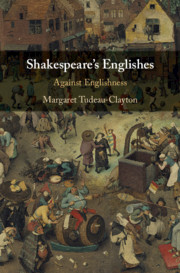Book contents
- Shakespeare’s Englishes
- Shakespeare’s Englishes
- Copyright page
- Epigraph
- Contents
- Table and Illustrations
- Acknowledgements
- Chapter 1 Introduction
- Chapter 2 Shakespeare and ‘the King’s English’
- Chapter 3 Shakespeare and ‘the true-born Englishman’
- Chapter 4 ‘they bring in straing rootes’
- Chapter 5 Figures and Parables of a ‘straing’ Word
- Bibliography
- Index
Chapter 3 - Shakespeare and ‘the true-born Englishman’
‘Theatre’ and the Ideology of National Character
Published online by Cambridge University Press: 07 October 2019
- Shakespeare’s Englishes
- Shakespeare’s Englishes
- Copyright page
- Epigraph
- Contents
- Table and Illustrations
- Acknowledgements
- Chapter 1 Introduction
- Chapter 2 Shakespeare and ‘the King’s English’
- Chapter 3 Shakespeare and ‘the true-born Englishman’
- Chapter 4 ‘they bring in straing rootes’
- Chapter 5 Figures and Parables of a ‘straing’ Word
- Bibliography
- Index
Summary
This chapter presents a history of the emergence and ideological uses made of the sartorial equivalent of the linguistic ‘gallimaufry’: the figure of the Englishman dressed in a motley of foreign fashions. The normative centre of the ‘true’ Englishman is defined through exclusion of what it is not, and this is what the figure represents. Deriving from verbal descriptions linked to the first visual portraits of an Englishman, the figure acquires gender and class inflections and woven into a historical narrative charged with an implicit future project of a ‘true’ (protestant) commonwealth of ‘true’ (pious, ‘plain’ and temperate) Englishmen to be achieved through its exclusion. The centre of the ‘true’ Englishman is dissociated from the male elite at court, perceived as effeminate and of extravagant foreign habits. It is in this context that the four instances of the figure in the Shakespearean canon are discussed. While the first three are shown to resist the turn by which the ‘true’ Englishman becomes a function of normative cultural habits, the fourth, in All’s Well that Ends Well, is shown to be more ambivalent, an ambivalence that may be linked to the political watershed of 1603
Keywords
- Type
- Chapter
- Information
- Shakespeare's EnglishesAgainst Englishness, pp. 93 - 131Publisher: Cambridge University PressPrint publication year: 2019



